Retrofit in Heritage Buildings
Understanding the Risks
Iain McCaig
 |
|
| Shrewsbury Flaxmill Maltings (Grade I, 1797), where Historic England is assessing the effects of internal wall insulation on the hygrothermal behaviour of brickwork (Photo: Jonathan Taylor, all other images: Iain McCaig/Historic England) |
It is a widely held view that older buildings are not energy efficient and must be radically upgraded in order to improve their performance. In reality the situation is more complicated and assumptions about poor performance are not always justified.
For example, as Dennis Rodwell points out in his article on heritage and sustainability, when HM Courts Service analysed their records of energy use they found that ‘…buildings from the early part of the 20th century and before tend to use less energy than the equivalent more recent buildings’. Nevertheless, opportunities exist to improve the energy and carbon performance of many heritage buildings, thereby helping them to remain viable and useful now and in the future.
The challenges in striking the right balance between benefit and harm can, however, be considerable. The unintended consequences of getting energy efficiency measures wrong (or doing them badly) include:
- harm to heritage significance: altered appearance, loss of features
- harm to human health and building fabric: poor indoor air quality, condensation and mould growth, decay of building fabric
- failure to achieve the predicted savings or reductions in environmental impact.
Getting the balance right is best achieved through a systematic ‘whole building’ approach. This is a logical process based on conservation planning principles that uses the understanding of a heritage asset, its context, significance and all the factors that affect energy use (not least, the people inhabiting it) as the starting point for devising strategies for energy efficiency.
Strategies may vary depending on whether the main aim is to mitigate carbon emissions, cut fuel bills or comply with legislation such as the Building Regulations. Compromises are inevitable, but the whole building approach enables informed decisions to be taken and ensures that improvements are suitable, well-integrated, properly coordinated, effective, cost-efficient and sustainable. It also provides an effective framework for communication between all parties involved in the process, including assessors, designers, installers and the people who will use and manage the building.
A ‘Mean, Lean, Green’ philosophy has evolved for the design, construction and use of new buildings. This is based on a hierarchy that begins with the siting, orientation, form, materials and construction of the building to optimise the efficient use of energy and other resources (‘Mean’). Next comes the design, management and control of engineering systems to ensure they can operate as efficiently as possible (‘Lean’). The final consideration is supplying energy requirements from renewable sources to minimise greenhouse gas emissions (‘Green’).
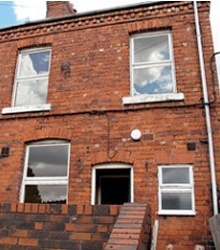 |
|
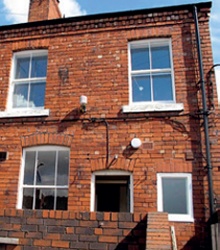 |
|
| Victorian end-of-terrace in New Bolsover, Derbyshire before (above) and after (below) installation of loft insulation, secondary glazing, internal wall insulation and insulation of the suspended timber ground floor. These thermal improvement measures increased the building’s SAP rating from E (46) to C (73). |
Although this philosophy can be applied in principle to existing buildings, a more nuanced approach is needed and the priorities will differ. For example, while the ‘fabric first’ approach (which focusses on achieving a high performance building envelope) makes perfect sense for a new building, in a historic building this may be neither practicable nor desirable. Instead, effective, cost-efficient and less risky measures that have minimal impact on heritage significance might be identified. Such measures include improving building services and controls, changing the way a building is occupied, used and managed, and questioning current expectations and standards to find out what is really necessary.
It is important to remember that success cannot be achieved by technical means alone – building owners, managers and occupiers play a crucial role and should be fully engaged in plans for saving energy at every stage.
Where building fabric improvements such as reducing uncontrolled air infiltration or adding insulation are considered desirable and feasible as part of a whole building energy strategy, careful consideration must be given to minimising the risks of unintended consequences. For example, if adequate provision is not made for ventilation, making a building more airtight can result in poor indoor air quality, with consequential health risks for the occupants. And the failure to remove excess moisture generated by activities within the building can lead to condensation and mould.
Similarly, the building may be harmed if added insulation adversely affects its benign ‘hygric balance’ (water in = water out) leading to a build-up of moisture within the fabric. Moisture problems caused by poorly designed and badly installed external wall insulation, or pre-existing building defects which allow rain to penetrate and become trapped are already becoming evident in some retrofitted buildings. In some of the worst cases buildings have been rendered uninhabitable.
The interactions between a building and the internal and external environments are complex and dynamic. It can be difficult, therefore, to fully predict the effects of particular retrofit measures and to assess the technical risks with any degree of certainty. Although the risk of moisture accumulation can be assessed using numerical models – a range of software applications of varying degrees of sophistication exists for this purpose – there is very little empirical evidence to validate the models.
Concerns about the risk of moisture accumulation associated with retrofitted wall insulation have prompted Historic England and others to obtain data from systematic site- and laboratory-based observations conducted over extended periods. The aim is to better understand the hygrothermal behaviour (heat and moisture transfer) of building elements and the effects of energy efficiency retrofit measures.
VICTORIAN END-OF-TERRACE, NEW BOLSOVER
New Bolsover is a model village built by the Bolsover Collier Company in 1891 on the outskirts of Bolsover, Derbyshire. It comprises 206 two- and three-storey brick houses (Grade II listed) arranged in double terraces on three sides of a square village green. In 2011 Historic England (then English Heritage) leased an end-of-terrace two-storey brick house and carried out a package of measures to improve the energy performance of the building envelope. This included loft insulation, secondary glazing, internal wall insulation and insulation of the suspended timber ground floor. Two types of wall insulation were used for comparison: a non-hygroscopic, vapour-closed system (polyisocyanurate or ‘PIR’), and a hygroscopic, vapour-open system (wood fibre).
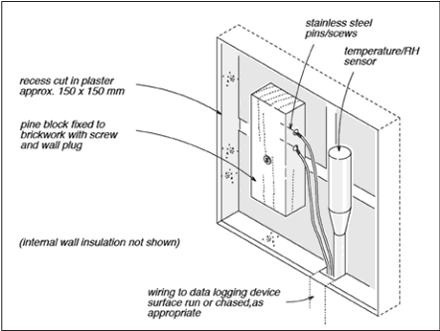 |
|
| Hygrothermal monitoring set-up at New Bolsover. Wooden blocks (or dowels) are a convenient method for assessing moisture content in historic building materials. The moisture content of the timber equilibrates to the relative humidity of its surroundings and can be determined (within limits) from measurements of electrical resistance. The humidity of the surroundings can then be deduced. |
The thermal performance of the building envelope was quantified before and after the improvements using in situ U-value measurements, co-heating and air pressurisation tests.
The improvements were also modelled using the government Standard Assessment Procedure (SAP) for the energy rating of dwellings, and the outputs compared with the measured results (see Further Information for details of the research report).
In addition, sensors were installed behind the internal wall insulation in 16 locations to monitor heat and moisture at the interface with the wall. In a heated building the addition of internal wall insulation will make the existing wall colder because it gains less heat from the interior of the building. As the wall becomes colder, its humidity increases.
This prompts two questions: does the wall remain sufficiently wet for long enough to harm building fabric? And does moisture tend to accumulate over time? The sensors installed measure temperature, relative humidity and the moisture content of a small block of wood (right).
Moisture monitoring at New Bolsover has been carried out continuously since 2011. During this period seasonal fluctuations have been observed, with walls becoming wetter in winter and drying out during the summer months. So far, no conclusive evidence of moisture accumulation behind either insulation system has been observed, but monitoring is continuing. (The results of the work to date will be published in an interim research report report which will be available for download from Historic England’s website).
GEORGIAN FLAX MILL, SHREWSBURY
Historic England has also been monitoring site trials to assess the effects of internal wall insulation on the hygrothermal behaviour of brickwork at Shrewsbury Flaxmill Maltings, Shropshire, (also known as Ditherington Flax Mill). The internationally important historic site comprises seven listed buildings, including the main mill (Grade I listed), built in 1797 to the designs of Charles Bage. It is the world’s first iron-framed building – a forerunner to the modern skyscraper.
The site ceased trading in 1987 and became derelict. English Heritage acquired it in 2005 and carried out emergency works to halt the decline of its buildings. Plans to bring the site back into sustainable beneficial use as a mixed-use commercial and residential development are in preparation. In this context questions have arisen about the extent to which wall insulation might form part of the energy strategy for the buildings, providing an ideal opportunity for further research into its effects.
Two systems of internal wall insulation, similar to those used at New Bolsover, have been installed in trial areas on three exterior walls in a room in the engine house adjoining the main mill. The 1½-brick thick walls face south, east and west respectively. The monitoring set-up is similar to that at New Bolsover, except that wooden dowel moisture sensors have been installed in holes drilled in the walls to within 50mm of the external faces. This allows moisture profiles through the thickness of the wall to be obtained, in addition to heat and moisture transfer data from the interface between the insulation and the wall.
During the winter months the room is heated and humidified to simulate occupation. Internal air temperature and relative humidity are monitored while a weather station records meteorological data. In addition, there are gauges to measure the amounts of wind-driven rain striking the elevations of the building. A little over a year’s worth of data has been gathered and is currently being analysed. However, differences in the hygrothermal behaviour of insulated and uninsulated walls, and variations resulting from the differing orientations of the walls are already apparent.
Interestingly, the largest differences between summer and winter temperature and humidity levels were observed in the exterior sections of the insulated walls. In contrast, the scale of the fluctuations in the exterior sections of the uninsulated walls was generally smaller. Further investigation will be needed to determine whether the magnitude of these fluctuations would be sufficient to increase the vulnerability of fragile brick surfaces to deterioration over time.
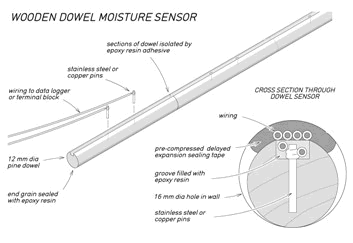 |
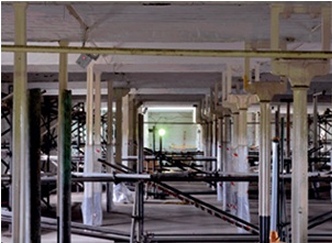 |
||
| Above left: Hygrothermal monitoring set-up at Shrewsbury Flaxmill Maltings: the dowels are cut into three sections isolated by epoxy resin. The ends of the dowels are also sealed with epoxy resin. In each section there is a pair of embedded electrodes which enable the electrical resistance to be measured remotely to provide a moisture profile through the thickness of the wall. Above right: The interior of the flax mill – the line of short cast iron columns once held the drive shaft to power the looms. | |||
WUFI
Measured data obtained from New Bolsover and Shrewsbury Flaxmill Maltings is also being used to investigate factors affecting the accuracy of heat and moisture transfer simulations using WUFI software (Wärme Und Feuchte Instationär or ‘heat and moisture transiency’) in a project being carried out on behalf of Historic England by Dr Paul Baker at Glasgow Caledonian University. The ability to predict the hygrothermal behaviour of building components is important in assessing and managing moisture risks.
WUFI software has been developed by the Fraunhofer Institute for Building Physics, Germany. It complies with BS EN 15026:2007 which sets out minimum requirements for simulation software use to predict one-dimensional transient heat and moisture transfer in multi-layer building components exposed on both sides to transient climate conditions.
In the first phase of the project, WUFI Pro 5 software was used to simulate the hygrothermal behaviour of brick walls, both insulated and uninsulated, at Shrewsbury Flaxmill Maltings over a period of 30 years (1960-1990) using historical meteorological data recorded at a nearby weather station. The simulations were carried out using the material properties of two bricks from the WUFI database (‘hand-formed brick’ and ‘historical brick’) plus the measured material properties of a third brick from the main mill building. Four types of insulation system were modelled:
- wood fibre
- mineral wool without an air and vapour control layer (AVCL)
- mineral wool with AVCL
- PIR.
Results of the various simulations were then compared.
There were significant differences between the results obtained when the measured properties of the Flaxmill brick were used instead of the WUFI database values. Clearly, it is better to use the measured properties of traditional building materials for hygrothermal simulations – there will always be uncertainties when using alternatives from the WUFI database. (This observation has also been made by other researchers.) It is a drawback of the application that the database contains no traditional UK building materials.
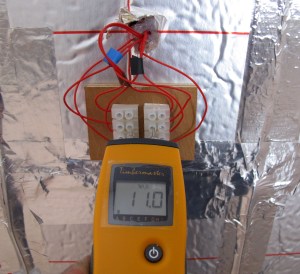 |
||
| Measuring the moisture content of the dowels manually, using a resistance moisture meter. The dowels are connected to terminal blocks located to suit the spacing of the pins on the moisture meter. This enables repeated measurements to be made quickly and easily. |
After comparing the simulation results obtained for the different types of insulation, wood fibre – which is hygroscopic and has some vapour diffusion resistance – appeared to be the best of the four systems. Mineral wool, although it has very low vapour resistance, is non-hygroscopic and therefore unable to buffer moisture. The insulation systems with higher vapour diffusion resistance – mineral wool with AVCL and PIR – appeared to cause moisture to accumulate within the walls in the long term.
Altering the rain adherence factor in the model had a significant effect on simulation results. The actual rain adherence factor at the Flaxmill is unknown, and may vary depending on the intensity of wind-driven rain. It may be possible to ‘calibrate’ the model by adjusting the rain adherence factor based on the site measurements of wind-driven rain. These, and other unknown boundary conditions led to a high level of uncertainty about the simulation results.
The next stages of the WUFI project will include sensitivity analysis of input parameters and the modelling of the walls at New Bolsover so that a direct comparison can be made between the simulation results and the measured data gathered over the past five years. In due course it will also be possible to compare the simulation results with measured data from Shrewsbury Flaxmill Maltings to provide further validation of the model. (A research report on the first phase of the hygrothermal modelling project can be downloaded from Historic England’s website, see Further Information.)
LOOKING AHEAD
In addition to the research described above, Historic England’s Building Conservation and Research Team is also investigating the effects of added insulation on the hygrothermal behaviour of roofs and suspended timber ground floors, including the role of ventilation in maintaining moisture at safe levels.
Building physics is complicated. Dr Paul Baker observed recently ‘It’s not rocket science – it’s harder! ’ And there are still many gaps in our knowledge and understanding. Therefore, a very welcome and timely development has been the launch earlier this year of the UK Centre for Moisture in Buildings (UKCMB). This not-for-profit organisation will work with partners from academia, government, industry and the public to substantially improve the way moisture risk is understood and managed in the UK. Watch this space.
~~~
Further Information
Historic England, A Retrofit of a Victorian Terrace House in New Bolsover: A Whole House Thermal Performance Assessment, 2015
Historic England, Ditherington Flax Mill: Hygrothermal Modelling, 2015
Historic England Research Report, External Wall Insulation in Traditional Buildings: Case studies of three large-scale project in the North of England, 2014
Historic England technical guides on energy efficiency and historic buildings are available here
Historic Environment Scotland guidance on saving energy in traditional buildings is available here
Sustainable Traditional Buildings Alliance, A Bristolian’s Guide to Solid Wall Insulation, BCC, 2015
Sustainable Traditional Buildings Alliance, Planning for Responsible Retrofit of Traditional Buildings, 2015
UK Centre for Moisture in Buildings



